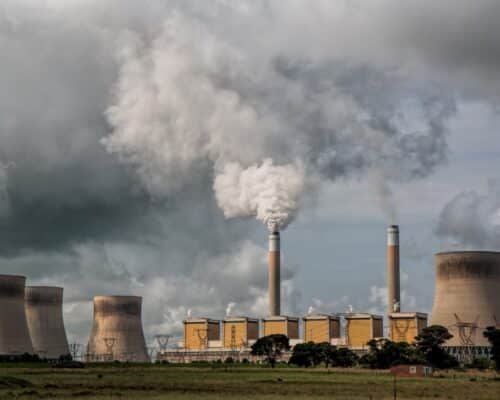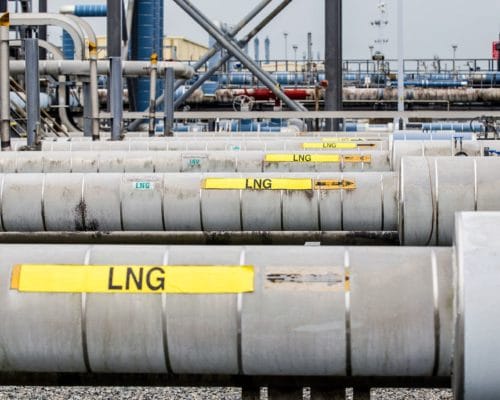Proposed Expansion of Gas Power in Asia Poses Climate and Economic Risks [Op-Ed]
Photo: Shutterstock/BigBlues
29 May 2023 – by Warda Ajaz Comments (0)
Countries in East and Southeast Asia are on the verge of an explosive growth in the development of gas-fired power plants, as countries aim to meet growing energy demand while turning away from coal power in search of lower emissions alternatives. With the Asian gas market predominantly reliant on LNG instead of piped gas, the 440 gigawatts (GW) of in-development gas-fired capacity in the region would mean a doubling of current LNG imports. This volume equals more than 6,500 additional cargoes from a standard 170,000 cubic meter carrier vessel, enough to meet the projected demand of roughly 484 million tonnes per annum (mtpa). By comparison, the total volume of LNG imports to Asia in 2022 was only 263.76 million tonnes.
Yet some countries have recently turned away from gas, largely due to the price volatility of imported LNG and competition from cheaper renewable energy. The political instability and price volatility associated with LNG markets are expected to continue, making it an insecure resource for countries to rely on as they expand their energy systems. Before major investments are made, Asian countries still have time to prevent a potentially devastating gas expansion and lock-in.
Proposed Growth: Significant and Consequential
Over 60% of the global gas-fired capacity in development, i.e., projects in the announced pre-construction and construction phases, are based in Asia. More than half of this capacity is concentrated in East and Southeast Asia.
In East Asia, China leads with an in-development capacity of 117 GW. Of this capacity, 32% is already in the construction phase. China is followed by Taiwan, which has 25 GW in development. Overall, East Asia represents 24% of the global in-development capacity and 39% of the in-development capacity in Asia.
In Southeast Asia, Vietnam leads with 44GW of gas power capacity in the pipeline. However, almost all of this capacity is in the proposal and pre-construction stages. The Philippines, with around 15 GW in development, shows a similar picture, as over 80% of its gas power projects are in the proposal and preconstruction stages. Southeast Asia represents 14% of global in-development capacity and 23% of in-development capacity in Asia.
The proposed gas expansion will be detrimental to climate goals, as any new fossil-based projects are “incompatible” with a target to limit planetary warming to 1.5°C. If operational, these units would emit over 750 million tonnes of CO2 annually, nearly doubling the current annual CO2 emissions of the existing operational fleet of gas power plants in Asia, which is roughly 1,300 million tonnes.
Asia is already witnessing the catastrophic impacts of climate change in the form of floods, severe heat waves and other extreme weather events. According to a World Meteorological Organization (WMO) report, Asia experienced over 100 natural hazards in 2021, 80% of which were flood and storm events. These caused around 4,000 deaths, directly affected nearly 50 million people and resulted in economic damages totalling US$35.6 billion.
Relying predominantly on imported LNG fuel is also an energy security risk for the region, exposing countries to global economic and political instabilities. Bangladesh and Pakistan struggled to afford LNG due to high prices, with Bangladesh purchasing LNG at a cost up to ten times higher than in mid-2020 and implementing rolling blackouts, which could continue until 2026.
At the same time, domestically-produced, renewable power can alleviate these issues and set Asian nations on a path of energy independence. Renewable energy technologies like onshore wind and solar projects present a wiser investment choice, as they now cost, on average, 40% less than new coal or gas plants.
Recent Project Cancellations and Re-considerations
Russia’s invasion of Ukraine led to LNG price spikes, which seem to have slowed the growth of gas infrastructure. Approximately 81 GW of previously planned capacity in Asia was cancelled in 2022 and 2023, representing 73% of global capacity cancellations in the last year (Project cancellation data is for the period of February 2022 to February 2023, except for Vietnam for which it was updated in May 2023 to reflect the changes in the approved PDP VIII)
Gas price increases and surging competition from renewables have also weakened the regional gas demand prospects. A predominantly mild winter and suppressed gas demand have led to a slight decrease in global gas prices. Still, prices remain two to three times higher than the average price prior to COVID-19, and prices are expected to stay elevated for the next few years because of tight LNG supplies that won’t see a considerable increase until the mid-2020s.
Consequently, some Asian nations have started seeing gas, especially LNG, as an expensive and unreliable fuel source. Last year, the International Energy Agency (IEA) slashed in half its 2022 forecast for emerging Asian gas demand growth from 2021-2025.
Pakistan has announced plans to phase out imported LNG as a power generation source in the long run. Instead, the country aims to increase its domestic power capacity, including solar and wind. Thailand has also decided to accelerate its shift to renewable energy to reduce its dependence on foreign fuel, planning to double its renewable capacity by 2030.
In the Philippines, its first LNG terminal was commissioned this year. However, competition from renewables might result in the underutilisation of this costly infrastructure, and the long-term economic sustainability of LNG-fueled power is already being questioned, as two power supply agreements are being renegotiated due to high costs. The revised power supply agreements will likely pass the high fuel costs on to consumers, who are already paying some of the highest tariffs in Asia.
These decisions might portent a window of opportunity for clean power technologies to increase their share in the energy mix. Recently, the Asian Development Bank and the Global Energy Alliance for People and Planet launched a new capital fund to expedite the green energy transition in South and Southeast Asia. Such initiatives could further support the transitions to renewables and away from fossil fuels in Asia.
A Window of Opportunity to Stop Further Gas Lock-in
The silver lining to these project cancellations is a clearer path to achieving the 1.5C target. Yet obstacles persist: for instance, Japan continues to push its “Green Transformation” policy, which promotes and finances LNG; ammonia co-firing; fossil hydrogen; and carbon capture, utilisation, and storage across Asia, all of which are known attempts to prolong the use of fossil fuel technologies rather than relying on clean energy resources. Policies like this often portray LNG as a cleaner alternative to coal, even though the methane emissions released during gas production make LNG equally harmful to the climate.
There is still time to slow or stop the gas expansion in Asia. Currently, roughly 70% of Asia’s gas-fired capacity in development is still in the announcement and pre-construction stages and can be stopped in the pipeline before any further investments are made. As Fatih Birol, Director of the IEA, recently wrote, “The push by some companies and governments to build new large-scale fossil fuel projects is not only a bet against the world reaching its climate goals — it is also a risky proposition for investors who want reasonable returns on their capital.”
About Global Energy Monitor
Global Energy Monitor (GEM) develops and shares information in support of the worldwide movement for clean energy. By studying the evolving international energy landscape, creating databases, reports, and interactive tools that enhance understanding, GEM seeks to build an open guide to the world’s energy system.
Disclaimer: The views and opinions expressed in this article are those of the author and do not necessarily reflect the official policy or position of Energy Tracker Asia.




